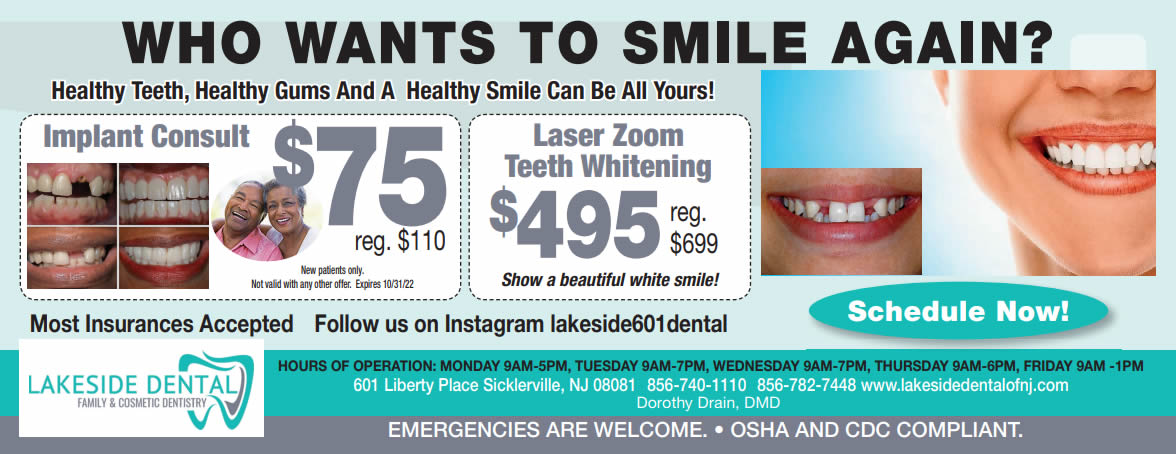
Your third molars, or wisdom teeth, are typically the last to emerge in your mouth. Some people may not even have them come through at all. Whether or not they erupt, wisdom teeth can cause problems if there isn’t enough space for them. If they become impacted, removal becomes even more critical.
Your dentist will monitor the development of your wisdom teeth through regular check-ups and X-rays, and may recommend extraction if there are signs they could lead to complications. Some dentists suggest removal even if the wisdom teeth aren’t impacted, as they can be hard to clean and more prone to decay. In some cases, wisdom teeth can become infected, which may require urgent medical attention. Symptoms of an infected wisdom tooth include:
- Pain in the tooth and gums
- Gum bleeding
- Gum inflammation
- Swelling in the face and jaw
- Headaches
- Bad breath
If your dentist recommends wisdom tooth extraction, it’s important not to delay the procedure, as it’s better to remove them before complications arise. Typically, you’ll be referred to an oral surgeon for the extraction. If only one tooth needs removal, local anesthesia may suffice. However, removing multiple wisdom teeth usually requires general anesthesia and is considered a day surgery, allowing you to go home afterward.
It’s crucial to follow your dentist’s post-surgery instructions to avoid complications. You may need to rest for a day or two, apply ice or heat for comfort, and be careful if stitches are involved. Your dentist will also provide guidance on which foods to eat during recovery. By following these instructions, you can expect to return to your normal routine soon and won’t have to worry about the issues wisdom teeth may cause in the future.
Ready to transform your smile? Schedule your appointment today at our Sicklerville dental office.

Wisdom tooth extraction is a common and safe procedure that many oral surgeons perform daily. While some people may fear the surgery, this is often due to misinformation or exaggerated tales. Understanding the process and recovery can help alleviate these fears.
Procedure:
The removal of wisdom teeth involves the following steps:
- The gum tissue over the tooth is opened, and any bone blocking the tooth’s eruption is removed.
- The tooth is extracted, sometimes in pieces, if necessary.
- In some cases where bone is removed, a bone graft may be placed.
- After the extraction, dissolvable stitches are placed to close the area.
Pain-Free Experience:
Patients are given sedation or anesthesia, ensuring they do not feel pain during the procedure. Many do not recall the surgery itself, making the process more manageable than it might seem.
Recovery:
Following the procedure, proper aftercare is crucial for a smooth recovery. Here are some key points to remember:
- Post-Surgery Instructions: Have someone accompany you to the appointment to hear the instructions and ensure you avoid driving.
- Bleeding Control: Bite gently on the provided gauze at the extraction site and change it frequently. Avoid lying flat on your back, as it may increase bleeding.
- Swelling Management: Apply ice packs to your cheeks on the first day to minimize swelling.
- Diet: Stick to soft foods and avoid straws for the first few days.
- Hygiene: Do not touch the area with your fingers or tongue.
- Avoid Smoking: Refrain from smoking for at least 24 hours after the surgery.
By closely following your surgeon’s instructions, you can minimize risks and recover quickly. Remember, most patients experience only mild discomfort for a few days, making wisdom tooth extraction a manageable procedure.
Take the first step towards optimal oral hygiene. Reserve your dental appointment at our Sicklerville dental office now and experience personalized care.

If you’re a current denture wearer, you know that dentures can make eating certain foods, especially crunchy or chewy ones, quite difficult. Issues like dentures clicking or moving while eating, or food debris collecting underneath, can lead to discomfort and a poor fit. Over time, if dentures aren’t properly cleaned, bad breath may develop due to odors trapped in the denture material.
The instability and retention issues of traditional dentures mean that many wearers have food restrictions, even when it comes to healthy, fresh foods they once enjoyed. Chewing these foods becomes difficult, which can affect digestion and overall health. Additionally, the bulkiness of standard dentures—particularly in the roof of the mouth—can reduce your enjoyment of the texture and flavor of food.
Hybrid dentures offer a solution to these challenges. Designed to keep the roof of the mouth open and uncovered, they enhance the texture and flavor of food, allowing you to enjoy eating again. Hybrid dentures are anchored securely with four or more dental implants, providing exceptional stability and preventing movement. This offers greater confidence in eating, drinking, and speaking.
If you’re looking for a way to improve your denture experience, talk to your dentist about hybrid dentures. They offer a more natural feel and function, giving you a smile that looks and feels just like your natural teeth.
Do you live in Sicklerville or the surrounding area? Our team is ready to help you achieve your smile goals. Schedule your appointment today.

If you are unhappy with the appearance of your smile due to stained, imperfect, or damaged teeth, consider visiting a cosmetic dentist for a smile makeover. Studies show that people with beautiful smiles are often perceived as more successful, trustworthy, and approachable. Beyond these obvious benefits, rejuvenating your smile through cosmetic dentistry offers many other advantages:
- Boosts Confidence and Enhances Self-Esteem
- Prevents Tooth Loss and Reduces the Risk of Infection – Straight, smooth teeth without gaps are easier to clean, reducing the chances of dental issues.
- Creates a Healthier, Youthful Appearance
- Restores Strength and Functionality of Teeth
- Makes Brushing and Flossing Easier
- Encourages Better Oral Hygiene Habits
- Provides Natural-Looking Results – Tailored to complement your facial structure.
At our Sicklerville dental office, we offer a wide variety of cosmetic and restorative treatments designed to improve your smile and overall oral health. Your smile makeover can be customized to fit your individual needs and may include some or all of the following procedures:
- Teeth Whitening
- Cosmetic Bonding
- Porcelain Veneers
- Tooth-Colored Fillings
- Dental Implants and Bridges
- Braces or Invisalign
- Gum Contouring
A smile makeover usually combines two or more treatments to achieve the desired results. Most procedures are non-invasive, and some can be completed in as little as one office visit, while others may require multiple appointments.
Thanks to advancements in dental technology, you no longer have to settle for a smile that doesn’t meet your expectations. Schedule a consultation with a qualified dental professional to learn how a smile makeover can help you achieve the smile you’ve always wanted.
Contact our Sicklerville dental office today for your personalized smile makeover.

If you have lost all of your teeth or just a few, you are probably a good candidate for dentures. Dentures, also known as removable prosthodontics, are used for the dental restoration or replacement of missing or broken teeth. You may want to consider dentures if any of the following apply to your situation:
- You have very few remaining teeth and they are in poor condition.
- You have suffered bone loss in your mouth so severe it precludes you from considering dental implants.
- You have advanced gum disease that has resulted in the loss of multiple teeth.
- You have lost many teeth, and your remaining teeth are suffering from decay and receding gums.
- You are committed to practicing excellent oral hygiene to take good care of your dentures.
You may not be a good candidate for dentures if any of the following apply:
- You are a young patient whose jawbone has not fully developed.
- You grind or clench your teeth.
- You have a sensitive gag reflex.
- You are a smoker.
If you feel you are a good candidate for dentures, your dentist will evaluate the health of your teeth and gums and determine if full or partial dentures are the best choice for you. There are many factors to consider when having dentures placed, and your dental professional can help you make a decision that fits your needs and lifestyle. If you wish to regain oral functionality and improve your smile, dentures may be your answer to once again enjoying a full set of beautiful, natural-looking teeth.
Do not wait any longer. Book your appointment now and achieve the smile you have always wanted. Dr. Drain is accepting new patients from Sicklerville and the surrounding area.

Most dental professionals recommend removing third molars, or wisdom teeth, during early adulthood, ideally before they are fully formed and rooted into the jaw. This typically involves extraction between the ages of 17 and 25. Delaying the removal of wisdom teeth can lead to significant risks and complications.
Wisdom teeth that are left in place can lead to the following risks:
- Impaction: Wisdom teeth may not have enough space to grow, causing pain and potential damage to surrounding teeth and tissues.
- Tooth decay: Wisdom teeth are difficult to clean, making them prone to decay.
- Infection: Bacteria can get trapped in the eruption site, causing infection.
- Cysts and tumors: Severely impacted wisdom teeth can lead to the growth of cysts or even tumors.
For patients needing wisdom teeth removal later in life, complications can include:
- More complicated surgery: Deeply rooted or impacted wisdom teeth may require more complex surgical procedures, leading to longer recovery times.
- Nerve damage: The roots of wisdom teeth may be close to nerves affecting the lower lip, and surgery could potentially damage these nerves, causing permanent sensation loss.
If you or your young adult have emerging wisdom teeth, it’s important to schedule a consultation with your dentist to assess whether and when extraction is necessary. While not all patients need wisdom teeth removed, extracting them during eruption can help avoid many future dental issues. Early removal typically leads to quicker recovery times and fewer complications.
Do you live in Sicklerville or the surrounding area? Our team is ready to help you achieve your smile goals. Schedule your appointment today.












